

Family Tree. Edward III of England. Edward III (13 November 1312 – 21 June 1377) was King of England from 25 January 1327 until his death; he is noted for his military success and for restoring royal authority after the disastrous reign of his father, Edward II.
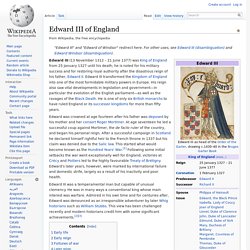
Edward III transformed the Kingdom of England into one of the most formidable military powers in Europe. His reign also saw vital developments in legislation and government—in particular the evolution of the English parliament—as well as the ravages of the Black Death. He is one of only six British monarchs to have ruled England or its successor kingdoms for more than fifty years. Edward III was a temperamental man but capable of unusual clemency. He was in many ways a conventional king whose main interest was warfare. Early life[edit] It was not long before the new reign also met with other problems caused by the central position at court of Roger Mortimer, who was now the de facto ruler of England.
Early reign[edit] Edward, the Black Prince. Edward of Woodstock, Prince of Wales, Duke of Cornwall, Prince of Aquitaine, KG (15 June 1330 – 8 June 1376) was the eldest son of King Edward III of England and his wife Philippa of Hainault as well as father to King Richard II of England.
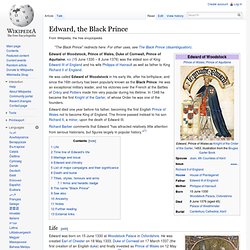
He was called Edward of Woodstock in his early life, after his birthplace, and since the 16th century has been popularly known as the Black Prince. He was an exceptional military leader, and his victories over the French at the Battles of Crécy and Poitiers made him very popular during his lifetime. In 1348 he became the first Knight of the Garter, of whose Order he was one of the founders. Richard Barber comments that Edward "has attracted relatively little attention from serious historians, but figures largely in popular history. Life[edit] Edward, the Black Prince is granted Aquitaine by his father King Edward III. Edward was born on 15 June 1330 at Woodstock Palace in Oxfordshire. Lionel of Antwerp, 1st Duke of Clarence. Lionel of Antwerp, 1st Duke of Clarence, jure uxoris 4th Earl of Ulster and 5th Baron of Connaught, KG (29 November 1338 – 7 October 1368) was the third son, but the second son to survive infancy, of Edward III of England and Philippa of Hainault.
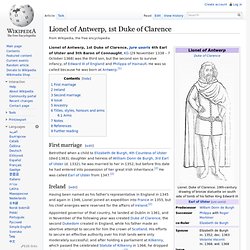
He was so called because he was born at Antwerp. First marriage[edit] Betrothed when a child to Elizabeth de Burgh, 4th Countess of Ulster (died 1363), daughter and heiress of William Donn de Burgh, 3rd Earl of Ulster (d. 1332), he was married to her in 1352, but before this date he had entered into possession of her great Irish inheritance.
He was called Earl of Ulster from 1347. Ireland[edit] Having been named as his father's representative in England in 1345 and again in 1346, Lionel joined an expedition into France in 1355, but his chief energies were reserved for the affairs of Ireland. Second marriage[edit] Edward IV. Richard III. John of Gaunt, 1st Duke of Lancaster. John of Gaunt, 1st Duke of Lancaster, KG (6 March 1340 – 3 February 1399) was a member of the House of Plantagenet, the third surviving son of King Edward III of England and Philippa of Hainault.
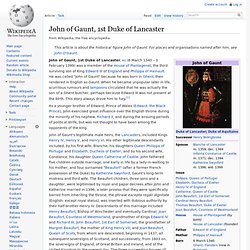
He was called "John of Gaunt" because he was born in Ghent, then rendered in English as Gaunt. When he became unpopular later in life, scurrilous rumours and lampoons circulated that he was actually the son of a Ghent butcher, perhaps because Edward III was not present at the birth. This story always drove him to fury.[1] Henry VI. Henry VII. Edmund of Langley, 1st Duke of York. Edmund of Langley, 1st Duke of York, 1st Earl of Cambridge, KG (5 June 1341 – 1 August 1402) was a younger son of King Edward III of England and Philippa of Hainault, the fourth of this Royal couple's five sons who lived to adulthood.
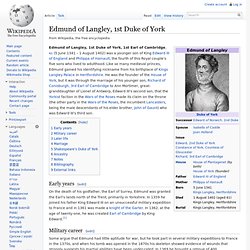
Like so many medieval princes, Edmund gained his identifying nickname from his birthplace of Kings Langley Palace in Hertfordshire. Edward IV. Richard III. Thomas of Woodstock, 1st Duke of Gloucester. Thomas of Woodstock, 1st Duke of Gloucester, 1st Earl of Buckingham, 1st Earl of Essex, Duke of Aumale, KG (7 January 1355 – 8 or 9 September 1397) was the fourteenth and youngest child of King Edward III of England and Philippa of Hainault.
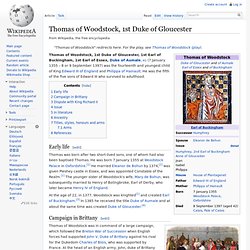
He was the fifth of the five sons of Edward III who survived to adulthood. Early life[edit] Thomas was born after two short-lived sons, one of whom had also been baptised Thomas. Henry V of England. Henry V (16 September 1386 – 31 August 1422[1][2]) was King of England from 1413 until his death at the age of 35 in 1422.
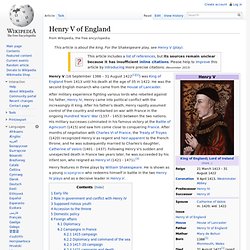
He was the second English monarch who came from the House of Lancaster. After military experience fighting various lords who rebelled against his father, Henry IV, Henry came into political conflict with the increasingly ill king. After his father's death, Henry rapidly assumed control of the country and embarked on war with France in the ongoing Hundred Years' War (1337 - 1453) between the two nations.
His military successes culminated in his famous victory at the Battle of Agincourt (1415) and saw him come close to conquering France. After months of negotiation with Charles VI of France, the Treaty of Troyes (1420) recognized Henry V as regent and heir-apparent to the French throne, and he was subsequently married to Charles's daughter, Catherine of Valois (1401 - 1437). Early life[edit] Henry VI of England - Wikipedia. Henry VI (6 December 1421 – 21 May 1471) was King of England from 1422 to 1461 and again from 1470 to 1471, and disputed King of France from 1422 to 1453.
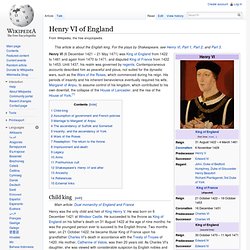
Until 1437, his realm was governed by regents. Contemporaneous accounts described him as peaceful and pious, not suited for the dynastic wars, such as the Wars of the Roses, which commenced during his reign. Edward IV of England. Edward IV (28 April 1442 – 9 April 1483) was King of England from 4 March 1461 until 3 October 1470,[1][2] and again from 11 April 1471 until his death in 1483.
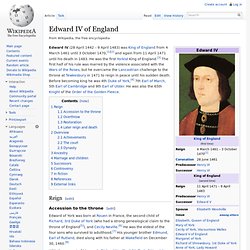
He was the first Yorkist King of England.[3] The first half of his rule was marred by the violence associated with the Wars of the Roses, but he overcame the Lancastrian challenge to the throne at Tewkesbury in 1471 to reign in peace until his sudden death. Before becoming king he was 4th Duke of York,[4] 7th Earl of March, 5th Earl of Cambridge and 9th Earl of Ulster. He was also the 65th Knight of the Order of the Golden Fleece. Reign[edit] Accession to the throne[edit] Richard III of England. When his brother Edward IV died in April 1483, Richard was named Lord Protector of the realm for Edward's son and successor, the 12-year-old King Edward V.
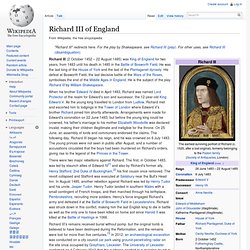
As the young king travelled to London from Ludlow, Richard met and escorted him to lodgings in the Tower of London where Edward V's brother Richard joined him shortly afterwards. Arrangements were made for Edward's coronation on 22 June 1483, but before the young king could be crowned, his father's marriage to his mother Elizabeth Woodville was declared invalid, making their children illegitimate and ineligible for the throne. On 25 June, an assembly of lords and commoners endorsed the claims. The following day, Richard III began his reign, and he was crowned on 6 July 1483. The young princes were not seen in public after August, and a number of accusations circulated that the boys had been murdered on Richard's orders, giving rise to the legend of the Princes in the Tower.
There were two major rebellions against Richard. Henry VII of England. Henry VII (Welsh: Harri Tudur; 28 January 1457 – 21 April 1509) was King of England and Lord of Ireland from his seizing the crown on 22 August 1485 until his death on 21 April 1509, as the first monarch of the House of Tudor.